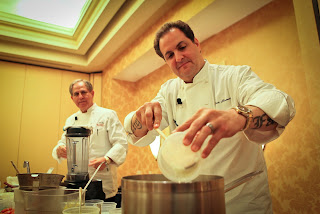Tomorrow, sports lovers and foodies will unite for a tailgating extravaganza unlike anything ever seen OR tasted before! And it’s all in the name of charity.
At the wildly anticipated rivalry game between top-ranked Louisiana State University and number-two University of Alabama, Chefs Folse and Tramonto will join culinary forces with long-time friend and football legend Bob Baumhower – founder of the Aloha Hospitality restaurant group – and Aloha Executive Chef Steve Zucker, to present the first-ever LouisiBama Gumbo Bowl, and set the Guinness World Record® for the largest pot of gumbo. Just how big is the 300 year-old cast iron pot that will hold this gigantic gumbo? Picture nearly two tons of Louisiana seafood, and you’ll start to get the idea.
Rivals for more than 100 years, LSU and ‘Bama will set aside the blood lust for a few hours to come together and raise money for Nick's Kids Fund (Alabama Coach Nick Saban’s charity) and Caring Days Adult Day Care (supported by Alabama Athletic Director Mal Moore), two local nonprofit organizations that are working hand-in-hand with the greater Tuscaloosa community to help rebuild homes and recreate services for dependent adults that were hit hard by the tornadoes that ripped through Tuscaloosa on April 27 of this year.
A star-studded roster of special guests – including Alabama Governor Robert Bentley, actress and Alabama alum Sela Ward, and former Florida State Coach Bobby Bowden – will be stopping by throughout the morning to help add ingredients to the simmering pot and give it a stir. After the gumbo is ready and the world record is announced, bowls will be served up to hungry and devoted football fans for $5 each.
If that isn’t enough excitement to get your taste buds hot and bothered, the day’s line-up will also include the Tailgate Cook-off! Four lucky fans each from the LSU and Alabama sides will face off in a culinary battle for gumbo domination. Stakes are high with legends like LSU champ A.J. Duhe, Alabama star Kenny “The Snake” Stabler, and football great Hugh Green judging. Don’t miss it!
 We invite you to buy your tickets now at http://gumbobowl2011.ticketbud.com/tornado-relief. They will also be sold on game day at the Gumbo Bowl event, taking place at Ferguson Student Center, near Alabama’s famous Bryant-Denny Stadium.
We invite you to buy your tickets now at http://gumbobowl2011.ticketbud.com/tornado-relief. They will also be sold on game day at the Gumbo Bowl event, taking place at Ferguson Student Center, near Alabama’s famous Bryant-Denny Stadium. We’ll be cheering on our top-ranked LSU Tigers (Geaux Tigers!), but whichever team wins the game, with the world’s largest pot of gumbo in the house, we’re pretty sure everyone wins. Hope to see you there!
- John and Rick








































